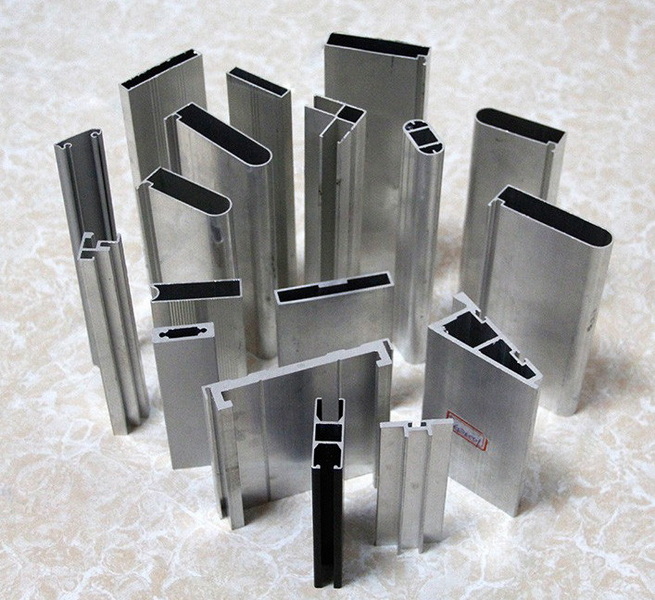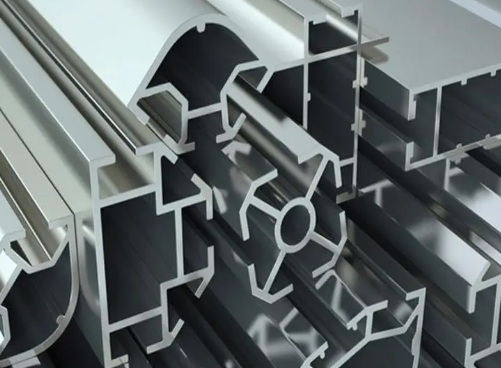English


Views: 222 Author: Tomorrow Publish Time: 2025-07-05 Origin: Site











Content Menu
● Introduction to Extruded Aluminum Profiles
● Step 1: Selection and Preparation of Raw Materials
● Step 3: Loading the Billet into the Extrusion Press
● Step 4: Extrusion of the Aluminum Profile
● Step 5: Cooling and Quenching
● Step 6: Cutting and Stretching
● Step 7: Aging and Heat Treatment
● Quality Control in Extrusion
● Applications of Extruded Aluminum Profiles
● Environmental and Economic Benefits
● FAQ
>> 1. What is an extruded aluminum profile?
>> 2. Why is aluminum commonly used for extrusion?
>> 3. How is the shape of an extruded aluminum profile determined?
>> 4. What are the main steps after extrusion?
>> 5. What industries use extruded aluminum profiles?
Extruded aluminum profiles are essential components widely used in various industries, including construction, automotive, aerospace, electronics, and furniture design. Their versatility, strength, and lightweight nature make them highly desirable for many applications. Understanding how extruded aluminum profiles are manufactured reveals the precision and engineering behind these indispensable materials.

An extruded aluminum profile is a long piece of aluminum shaped with a specific cross-sectional design. This shape is achieved by forcing heated aluminum alloy through a die with an opening that matches the desired profile. The extrusion process allows for the creation of complex shapes, including solid, hollow, and semi-hollow profiles, tailored to meet specific functional and aesthetic requirements.
Extruded aluminum profiles offer several advantages over other manufacturing methods. They provide excellent dimensional accuracy, high strength-to-weight ratios, and the ability to integrate multiple functions into a single profile, reducing assembly time and cost. Moreover, aluminum's natural corrosion resistance and recyclability make these profiles environmentally friendly and sustainable.
The manufacturing process begins with selecting high-quality aluminum billets, which are cylindrical blocks of aluminum alloy. The alloy composition varies depending on the intended use of the final product, affecting mechanical properties such as strength, corrosion resistance, and machinability. Common alloys include series like 6000 and 7000, which offer a good balance of strength and workability.
The billets are produced through casting processes that ensure uniformity and purity, critical for the performance of the extruded profiles. The quality of the billet directly influences the surface finish and structural integrity of the final profile.
Before extrusion, the billets are preheated to a temperature typically between 400°C and 500°C (750°F to 930°F). This heating makes the aluminum malleable but not molten, enabling it to flow smoothly through the die without cracking or deforming improperly. Proper billet temperature is crucial to avoid defects like surface cracking or internal voids.
The die is a crucial tool in the extrusion process. Made from hardened steel, the die has an opening shaped exactly like the desired cross-section of the aluminum profile. Dies can be simple or complex, producing profiles ranging from basic rods and tubes to intricate structural shapes like channels, I-beams, and custom designs.
Before use, the die is preheated, usually to around 450°C to 500°C, to maintain consistent temperature during extrusion and reduce thermal shock to the aluminum billet. This preheating also helps in achieving a smooth surface finish on the extruded profile and prolongs the die's lifespan.
Designing the die requires expert knowledge of metal flow dynamics and thermal expansion. The die must be engineered to allow aluminum to flow evenly, preventing defects such as warping or uneven thickness. Often, dies include features like bridges and supports to maintain complex hollow sections.
Once the billet and die are preheated, the billet is loaded into the extrusion press container. The press uses a hydraulic ram that applies immense pressure, sometimes up to 15,000 tons, to push the billet forward. The billet is compressed against the die, initially expanding to fill the container and then being forced through the die opening.
The extrusion press is a highly specialized machine, capable of exerting the tremendous force necessary to shape the aluminum. The speed of extrusion is carefully controlled to balance productivity with quality, as too fast a speed can cause defects and too slow can reduce efficiency.
As the hydraulic ram pushes the billet, the aluminum is squeezed through the die opening, emerging as a continuous length of aluminum with the exact cross-sectional shape of the die. This newly formed extruded aluminum profile is still hot and malleable as it exits the press.
The extrusion process is comparable to forcing Play-Doh through a shaped mold, but with precise control over temperature, pressure, and speed to ensure dimensional accuracy and material integrity. The extruded profile's surface quality is influenced by factors such as billet cleanliness, die condition, and extrusion parameters.
Immediately after extrusion, the hot aluminum profile is cooled rapidly in a process called quenching. This is typically done using a water bath or air fans along a runout table that guides the extrusion away from the press. Quenching helps to solidify the profile uniformly and enhances its mechanical properties by controlling the cooling rate.
The cooling method and rate significantly affect the microstructure and mechanical properties of the aluminum. Rapid cooling can increase strength but may induce residual stresses, while slower cooling improves ductility. Manufacturers optimize cooling based on the alloy and profile design.
Once cooled to a manageable temperature, the extrusion is cut to predetermined lengths, usually between 8 and 21 feet. However, the profiles may have slight twists or bends due to the extrusion process. To correct this, the profiles are mechanically stretched on a stretcher machine. This stretching aligns the grain structure, straightens the profile, and improves dimensional stability.
Stretching also enhances mechanical properties by work hardening the aluminum. This step is essential for ensuring that the extruded aluminum profiles meet strict tolerance and performance standards required for their applications.

After stretching, the extruded aluminum profiles often undergo aging or heat treatment to achieve the desired temper and mechanical properties. Aging can be done naturally at room temperature or artificially in aging ovens. This step enhances strength, hardness, and durability, making the profiles suitable for demanding applications.
Heat treatment processes vary depending on the alloy and the required final properties. For example, 6000 series alloys typically undergo solution heat treatment followed by artificial aging to optimize strength and corrosion resistance.
Extruded aluminum profiles can receive various surface treatments to improve appearance, corrosion resistance, and wear resistance. Common finishing methods include:
- Anodizing: Converts the aluminum surface into a durable oxide layer, enhancing corrosion resistance and allowing for color finishes. Anodizing also improves surface hardness and wear resistance.
- Powder Coating: Electrostatic application of pigment particles followed by curing to create a protective and decorative layer. Powder coating offers a wide range of colors and textures and excellent weather resistance.
- Fluorocarbon Coating: Multi-layer paint application offering excellent weather resistance and self-cleaning properties, often used for architectural applications.
These treatments not only protect the profiles but also add aesthetic value and extend their service life. Surface finishing is often customized based on the profile's end-use environment and design requirements.
Throughout the manufacturing process, rigorous quality control measures are implemented to ensure the extruded aluminum profiles meet precise specifications. This includes dimensional inspections using coordinate measuring machines (CMM), surface finish assessments, and mechanical testing for tensile strength, hardness, and elongation.
Non-destructive testing methods such as ultrasonic inspection and X-ray analysis may be used to detect internal defects. Consistent quality control ensures that the profiles perform reliably in their intended applications.
Due to their customizable shapes and excellent properties, extruded aluminum profiles are used in:
- Structural frameworks for buildings and machinery
- Automotive parts and components, including chassis, roof rails, and heat exchangers
- Aerospace structures where lightweight and strength are critical
- Electronic housings and heat sinks that require efficient thermal management
- Furniture and interior design elements, offering sleek aesthetics and durability
- Renewable energy equipment such as solar panel frames and wind turbines, benefiting from corrosion resistance and strength
Their lightweight nature combined with high strength makes them ideal for applications where weight reduction is critical without compromising durability. Additionally, the ability to integrate multiple functions into a single profile reduces assembly complexity and cost.
Extruded aluminum profiles contribute to sustainability efforts due to aluminum's recyclability. Aluminum can be recycled repeatedly without losing its properties, reducing the need for primary aluminum production, which is energy-intensive.
The extrusion process itself is energy-efficient compared to other metal forming techniques. The ability to produce complex profiles in long continuous lengths minimizes waste and reduces the number of components required in assemblies.
The manufacturing of extruded aluminum profiles is a sophisticated process involving precise control of materials, temperature, pressure, and finishing techniques. From selecting the right alloy billet to shaping it through a custom die and applying surface treatments, every step is designed to produce profiles that meet stringent performance and design requirements. This process enables the creation of versatile, high-strength, and lightweight aluminum components essential to modern industry and technology.
The combination of advanced metallurgy, engineering, and quality control ensures that extruded aluminum profiles continue to play a vital role in innovation across multiple sectors, offering sustainable and cost-effective solutions.

An extruded aluminum profile is a long aluminum piece shaped by forcing heated aluminum alloy through a die with a specific cross-sectional opening, resulting in a continuous profile matching the die shape.
Aluminum is favored for extrusion due to its excellent strength-to-weight ratio, corrosion resistance, malleability when heated, and ability to be formed into complex shapes cost-effectively.
The shape is determined by the design of the extrusion die, which has an opening matching the desired cross-sectional profile. Dies can create solid, hollow, or semi-hollow shapes.
After extrusion, the profile is quenched to cool it uniformly, cut to length, stretched to straighten and align, aged for mechanical properties, and finished with surface treatments like anodizing or powder coating.
Extruded aluminum profiles are used in construction, automotive, aerospace, electronics, furniture, and renewable energy sectors, among others, due to their strength, lightweight, and customizable shapes.
Stainless Steel Grades 201 Vs 304: Cost Vs Performance Breakdown
316L Vs 316 Stainless Steel Grades: Which Is Better for Corrosion Resistance?
Comparing Austenitic Vs Martensitic Stainless Steel Grades: What You Need To Know?
Stainless Steel 430 Vs 304: Key Differences Explained for Manufacturers
304 Vs 316 Stainless Steel Grades: Which One Suits Your Project Best?
Stainless Steel Pipes Vs Galvanized Pipes: Durability And Cost Analysis
Comparing Stainless Steel Pipes And PVC Pipes: What You Need To Know?
Stainless Steel Pipes Vs Copper Pipes: Pros And Cons for Industrial Use
Seamless Stainless Steel Pipes Vs Welded Pipes: Key Differences Explained
Stainless Steel Pipes Vs Carbon Steel Pipes: Which One Suits Your Project?
